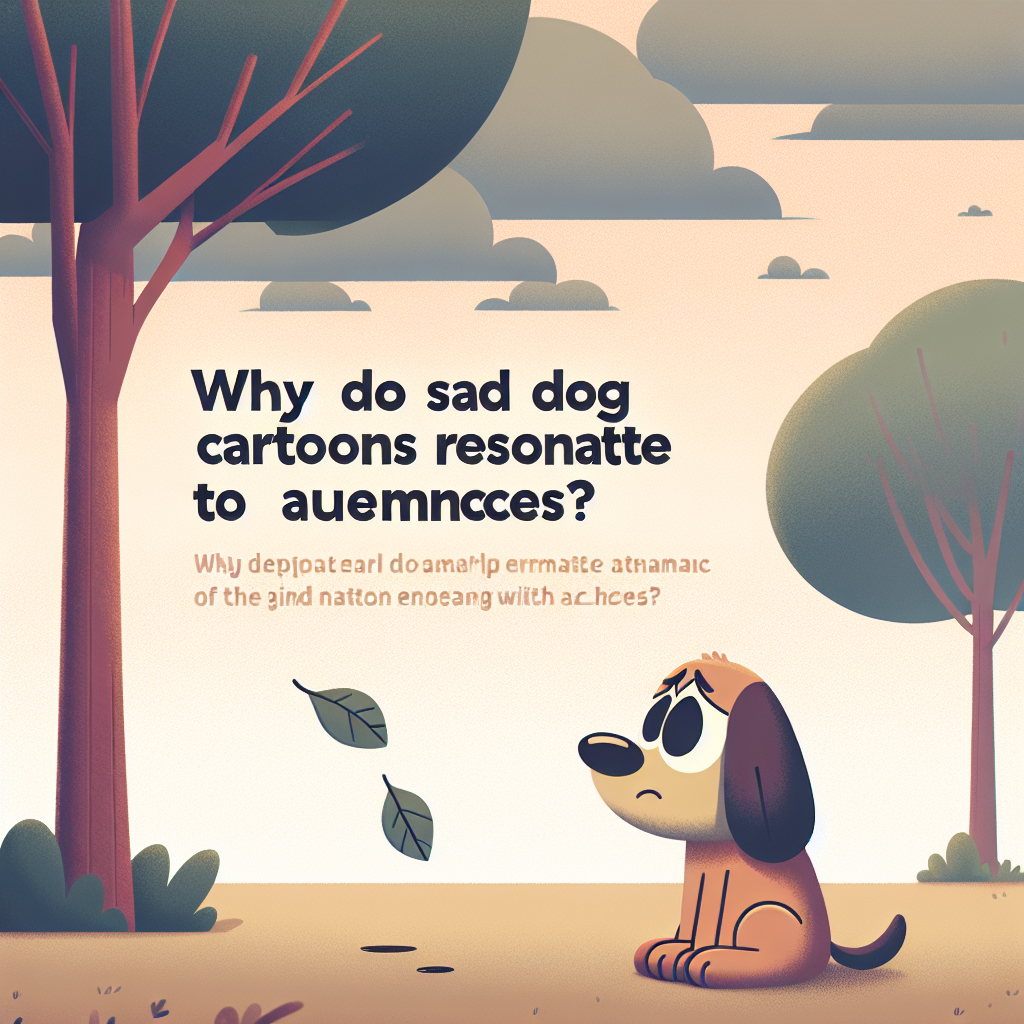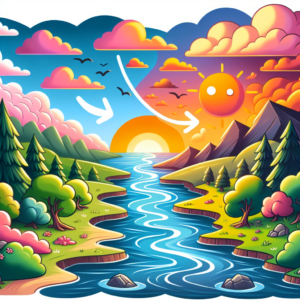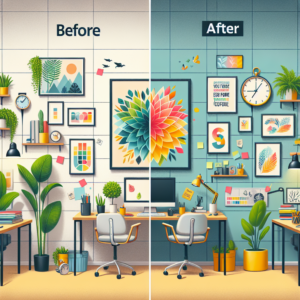Have you ever found yourself tearing up at the sight of a sad cartoon dog on your screen? Maybe it was when you watched the heart-wrenching scene of a loyal pup waiting for his owner to come back, or the touching moment of a dog saying goodbye to his best friend. Whatever the scenario, sad dog cartoons have a way of tugging at our heartstrings and leaving a lasting impact on us. But have you ever wondered why these animated canines evoke such strong emotions in us? Let’s delve into the world of sad dog cartoons and uncover the reasons why they resonate with audiences.
The Power of Emotional Connection
One of the key reasons why sad dog cartoons strike a chord with viewers is the power of emotional connection. Dogs are known for their unwavering loyalty, unconditional love, and expressive nature, making them one of the most beloved and relatable animals in the world. When we see a cartoon dog in distress or sadness, it evokes empathy and compassion within us because we can relate to their emotions on a deep level. Whether we have had a personal experience with a dog or simply love animals, the bond we share with these furry companions makes it easy for us to empathize with their struggles and feel their pain.
The Element of Nostalgia
Another reason why sad dog cartoons resonate with audiences is the element of nostalgia. For many of us, our childhood memories are filled with cartoons featuring lovable dog characters such as Scooby-Doo, Snoopy, and Lassie. These animated pups not only entertained us but also taught us valuable life lessons about friendship, loyalty, and love. When we see a sad dog cartoon as adults, it may trigger a sense of nostalgia and remind us of the innocence and simplicity of our youth. This nostalgic connection enhances our emotional engagement with the storyline and characters, making it easier for us to become emotionally invested in their journey.
The Universality of Emotions
Emotions are a universal language that transcends cultural, linguistic, and geographical boundaries. Sadness, loneliness, grief, and heartbreak are emotions that we all experience at some point in our lives, regardless of our background or beliefs. When we watch a sad dog cartoon, we are reminded of our own emotional struggles and vulnerabilities, which creates a sense of connection and understanding between us and the animated characters. This shared experience of emotions helps us feel a sense of kinship with the cartoon dogs and allows us to empathize with their plight on a deeper level.
The Appeal of Redemption Arcs
Many sad dog cartoons follow a classic narrative structure known as the redemption arc, where the protagonist undergoes a journey of personal growth, self-discovery, and transformation. In these stories, the sad dog starts off in a state of despair or hopelessness but eventually finds redemption, healing, and happiness through the support of friends, family, or a kind stranger. This narrative arc resonates with audiences because it mirrors our own struggles and challenges in life, and offers a message of hope, resilience, and second chances. By witnessing the transformation of a sad dog into a joyful and fulfilled character, we are inspired to believe in the power of love, compassion, and kindness to overcome adversity.
The Art of Visual Storytelling
Sad dog cartoons leverage the art of visual storytelling to convey complex emotions, themes, and messages in a simple and accessible way. Through the use of expressive facial expressions, body language, and visual cues, animators can effectively communicate the inner thoughts and feelings of the cartoon dogs without the need for words. This visual communication allows audiences to connect with the characters on a deeper, more intimate level, as they are able to interpret and empathize with their emotions through visual cues alone. The power of visual storytelling in sad dog cartoons lies in its ability to evoke raw, unfiltered emotions and create a visceral emotional response in viewers.
The Cathartic Release of Emotions
Watching sad dog cartoons can be a cathartic experience for audiences, as it allows us to channel and release pent-up emotions in a safe and controlled environment. By empathizing with the struggles and hardships of the animated dogs, we are able to process our own emotional baggage, insecurities, and fears in a non-threatening way. This emotional release can be therapeutic and healing, as it enables us to acknowledge, confront, and express our feelings in a supportive and empathetic space. The cathartic effect of sad dog cartoons provides a sense of emotional relief, validation, and release, which can be comforting and empowering for viewers.
The Symbolism of Dogs in Culture
Dogs have held a special place in human culture and society for centuries, symbolizing loyalty, companionship, protection, and unconditional love. Throughout history, dogs have been revered as faithful companions, guardians, and helpers who bring joy, comfort, and purpose to our lives. In many cultures and religions, dogs are seen as sacred or spiritual beings with the power to heal, guide, and comfort us in times of need. The symbolism of dogs in culture enhances the emotional impact of sad dog cartoons, as it taps into our deep-seated beliefs, values, and associations with these beloved animals.
The Importance of Emotional Resonance
At the heart of sad dog cartoons lies the importance of emotional resonance, which refers to the ability of a story, character, or experience to evoke strong emotions, connections, and responses in audiences. Emotional resonance is what makes a sad dog cartoon memorable, impactful, and meaningful to viewers, as it creates a lasting impression and emotional connection that lingers long after the cartoon has ended. By tapping into our emotions, beliefs, and experiences, sad dog cartoons have the power to touch our hearts, minds, and souls in a profound and profound way.
The Healing Power of Empathy
Empathy is the ability to understand and share the feelings of another, and it plays a crucial role in our emotional and social well-being. When we empathize with the struggles and sorrows of a sad dog cartoon, we are practicing empathy and compassion towards a fictional character, which helps us develop our emotional intelligence, sensitivity, and empathy in real life. The healing power of empathy lies in its ability to connect us with others, foster understanding and acceptance, and promote kindness, empathy, and mutual support in our relationships and communities. By engaging with sad dog cartoons, we are not only experiencing emotional catharsis but also nurturing our capacity for empathy, connection, and healing.
Why do sad dog cartoons make us cry?
Sad dog cartoons evoke strong emotions in us because they tap into our empathy, nostalgia, and shared experiences with dogs as loyal and loving companions. The emotional connection we feel with the cartoon dogs, combined with the themes of redemption, transformation, and resilience, creates a powerful and poignant narrative that resonates with our hearts and minds.
How can sad dog cartoons be therapeutic?
Watching sad dog cartoons can be therapeutic because it allows us to process and release pent-up emotions in a safe and controlled environment. By empathizing with the struggles and hardships of the animated dogs, we can confront our own emotional baggage, insecurities, and fears in a supportive and empathetic space. This emotional release can be cathartic, healing, and empowering, as it enables us to acknowledge, express, and validate our feelings in a non-threatening way.
What is the significance of the visual storytelling in sad dog cartoons?
The visual storytelling in sad dog cartoons plays a crucial role in conveying complex emotions, themes, and messages in a simple and accessible way. Through the use of expressive facial expressions, body language, and visual cues, animators can effectively communicate the inner thoughts and feelings of the cartoon dogs without the need for words. This visual communication allows audiences to connect with the characters on a deeper, more intimate level, as they are able to interpret and empathize with their emotions through visual cues alone.








+ There are no comments
Add yours